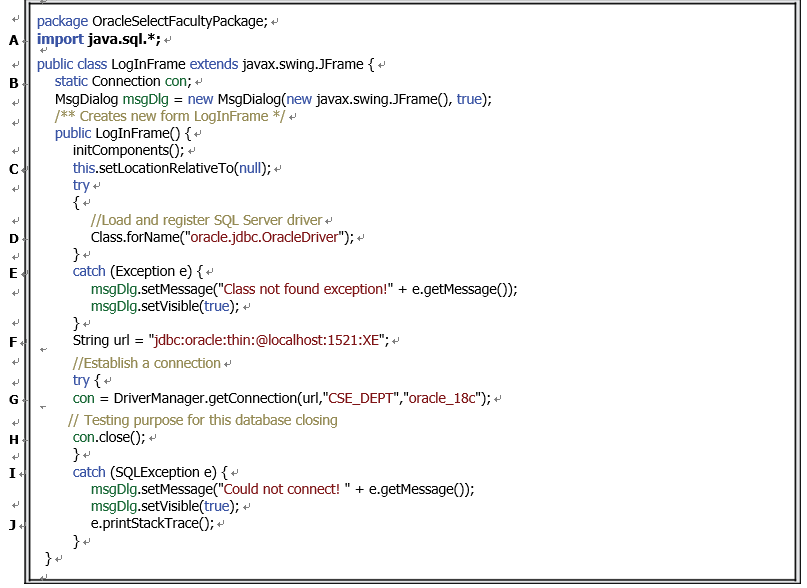6.3.4 Develop Code for the LogIn Table to Connect to Our Sample Database
Now let’s develop the code to load and register the Oracle JDBC Driver in our LogInFrame class. Open the Code Window of the LogInFrame by clicking on the Source tab at the top of the win-dow, and enter the code shown in Figure 6.14 into this window.
Let’s have a closer look at this piece of code to see how it works.
A. Since all JDBC-related classes and interfaces are located in the java.sql package, we first need to import this package.
B. A class instance, con, is declared here since we need to use this connection object in our whole project. A MsgDialog object is also created, and we need to use it in this form.
C. The setLocationRelativeTo() method is called to set up theLogInFrame Form at the center of the screen as the project runs. A null argument means that no object can be referenced or relatedto, and the JFrame Form is set to the center.
D. A try-catch block is used to load and register our Oracle JDBC Driver. The default method, Class.forName(), is utilized to make sure that our JDBC Driver is not only loaded but also registered when it is connected by running the getConnection() method in step 7 later. The argument of this method is the name of our Oracle JDBC Driver class, and it was created by NetBeans when we added this driver to our project in Section 6.2.
E. The catch block is used to track any possible error in loading and registering. The related exception information will be displayed if any error occurs.
F. The connection url, which includes the protocol, subprotocol and subname of the data source, is created to define a full set of information for the database to be connected.

FIGURE 6.14 Code for loading and registering a JDBC Driver.
G. Another try-catch block is used to perform the database connection by calling the getConnection() method. Three arguments are passed into this method: url, user-name and password.
H. The connected database is disconnected by calling the close() method. This instruction is only for testing purposes for this LogInFrame Form, and it will be removed later when we build the formal project, since we need to keep this single database connection active during the entire running period of our project until the project is terminated.
I. If any possible exception occurred during this connection process, it would be displayed by using this catch block.
J. This prints the Throwable and its backtrace to the standard error stream. This method prints a stack trace for the Throwable object on the error output stream that is the value of the field System.err. The first line of output contains the result of the toString() method for this object. The remaining lines represent data previously recorded by the method fillInStackTrace().
The reason we put the piece of code that includes the loading, registering and connection to our JDBC Driver inside the constructor of the LogInFrame class is that we need to set up and complete these operations first, before other data actions can be performed, since a valid database connection is a prerequisite for any database query operation.
Next let’s use the PreparedStatement component to build our dynamic query to our LogIn Table in our sample database.
